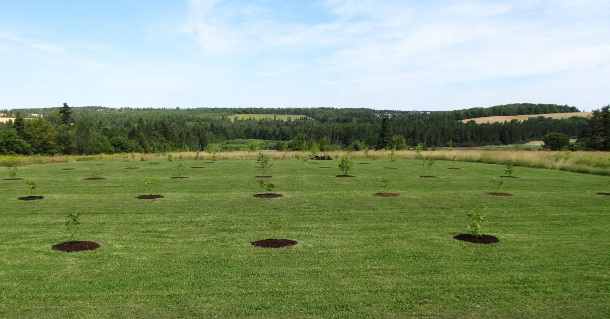
Through TD Green Streets funding, the City of Charlottetown, PE established a small native tree nursery to provide an acclimatized, local source of native trees for the reforestation of 206 acres of land that was purchased by the city in 2011, and for use on other City properties such as watershed riparian zones, woodlands and green spaces. (Photo: City of Charlottetown)
This article is the first of a series that aims to plant innovative, inspiring, and actionable seeds in the realms of community-building, art, and arboriculture. These seeds will be planted by providing readers with information on funding programs and opportunities for environmental projects alongside discussion of related concepts/projects in contemporary art. What will grow exactly depends, of course, on the reader… -LM
TD Green Streets is a North American program sponsored by TD Bank that provides grants for projects on the leading edge of municipal forestry. These projects include urban forest planning, demonstration projects, workshops (policy & best management), outreach and educational activities, management tools, urban design showcasing green infrastructure, and innovative plantings. In Canada, the program provides $300,000 in matching grants to communities nationwide (valued at up to $15,000 each). In the US, the program awards 10 municipalities with grants of $20,000 to support projects benefitting low- to moderate-income communities.
Today I’ll be sharing information, guidance, and a dash of creative inspiration for municipalities with relevant projects who are interested in applying for TD Green Streets funding. As I will elaborate further later, the creative/artistic component here is by no means a requirement for TD Green Streets grants. I’m including a discussion of it here in order to encourage applicants to “push the envelope” in terms of creative approaches to community engagement, and to create an access point for artists who are interested in the environment to develop ideas for how they might directly engage their own communities and urban forests.
Launched in 1994 as Tree Canada’s flagship program, Green Streets has provided $60 million in funding to over 500 Canadian communities to encourage and support the adoption of innovative practices in municipal forestry. Following the success of the program in Canada, this year TD Green Streets was launched in the US, where it is administered by the Arbor Day Foundation. The first US applicants’ projects are currently underway.
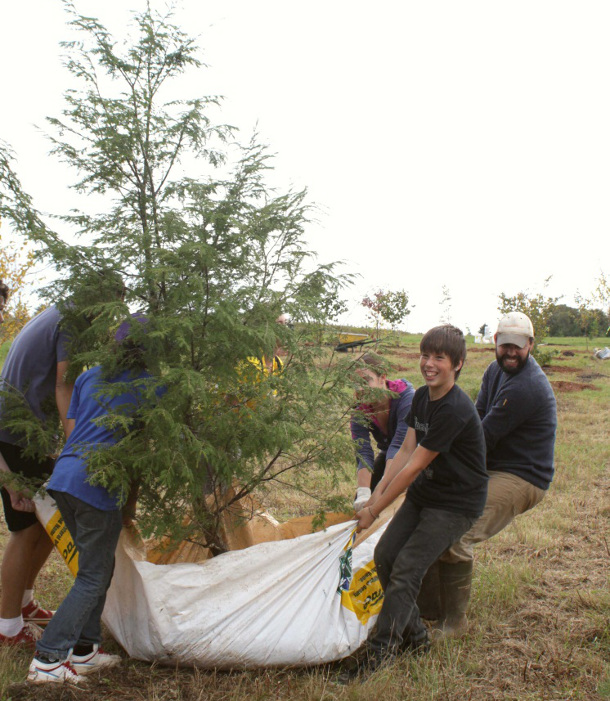
The 206 acres of land in Charlottetown were developed as a well field, providing a new source of water for the City. To protect the wellhead site and buffer it from adjacent agricultural land, the City developed a comprehensive plan to reforest the majority of the property. Over 8,800 softwood and hardwood trees were planted on the property. Hedgerows between the site and privately owned land were enhanced with an additional 996 white spruce trees. The City worked with several organizations including Island Nature Trust, Macphail Woods Ecological Forestry Project, and Winter River Watershed-Tracadie Bay Watershed Association. (photo: City of Charlottetown)
Projects funded through TD Green Streets most often involve a large-scale tree planting component that offers a direct way to engage citizens and volunteers in the growing and maintenance of the urban forest. In addition to providing this opportunity for direct engagement, it also presents an opportunity for publicity and large scale engagement from the wider community. In fact, a commitment to recognize the program via public launch event or press conference is a requirement for awarded projects.
The scope of eligible municipalities is wide: the Canadian program is open to all municipalities and Aboriginal communities, as well as Business Improvement Associations. The US program is open to recognized Tree City USA communities situated in TD Bank’s retail footprint, which extends from Maine to Florida. Selected projects involving plantings range in scale from dozens of trees to thousands, and engage volunteers from local schools and organizations. In addition to plantings, selected projects may also include policy and best management workshops, outreach and educational activities, development of innovative management tools, or staff/volunteer training that serve to bring communities to the leading edge of municipal forestry.
Tips for a strong application, from TD Green Streets:
- Robust descriptions of how you will evaluate the success of your program. You must demonstrate that there is system in place at community/municipal level for evaluating the success of your program 2-5 years in the future.
- Thoughtful consideration for how your program/project can be adopted by other communities. This can take the form of best practices manuals or workshops that can be used by other communities, or the organization of workshops or conferences that service additional communities – something that makes it possible for other communities to adopt what you are doing.
- Innovative approaches to guaranteeing survivability of plants, thoughtful maintenance plans including details on watering, mulching, etc. Remember that planting the tree may be the easiest part, you must show a commitment to keeping the trees healthy and prosperous.
- Demonstration of technical expertise, involvement of arborists, foresters, or other resource technician.
- A demonstrated commitment to the training and continuing education of community staff and volunteers through workshops, accreditation, conferences, etc. This commitment involves raising employees’ level of expertise and could include sending staff to conferences or bringing in experts to train municipal staff/volunteers.
- Commitment to recognize the TD Green Streets program, including program partners, through a public launch event or press conference and the placement of an ad in local print media.
- Strong component of community engagement, educational outreach, and collaboration with other community organizations, non-profit partners, or the private sector.
Although I emphasize that community engagement is only one aspect of successful projects as a whole (in addition to those mentioned above), I want to use it as an opportunity to step back and consider some history behind community engagement in contemporary art practices – and how it might apply to current TD Green Streets applications.
Few people working in municipal forestry profession are probably familiar with Social Sculpture, an artistic concept/methodology first articulated in the 1970s by German conceptual artist Joseph Beuys. I think this topic has a direct application to community-based forestry.
Beuys used the term to describe the transformative potential that art, as a human activity, holds for society and the environment. More recently the term has been described[1] as “a generic term to refer to any work that has an emphasis on imaginative, participatory practices; to relational or connective aesthetics; and to works that involves people in a transformative process and have a social dimension or focus.” In other words – social sculpture is any structured activity that fosters creative interaction and participation with one’s environment and society. Many art historians may contradict me, but using this definition I would say that any large scale municipal undertaking that involves citizen participation, such as the implementation of an innovative tree planting plan, would fall into the category of social sculpture.
To that end, this idea of transformation, both of the environment and the community inhabiting it, echoes a core aspect to the TD Green Streets Program: empowering citizens on a municipal scale to engage actively and creatively in the urban forest and raise awareness of the social dimension of green infrastructure.
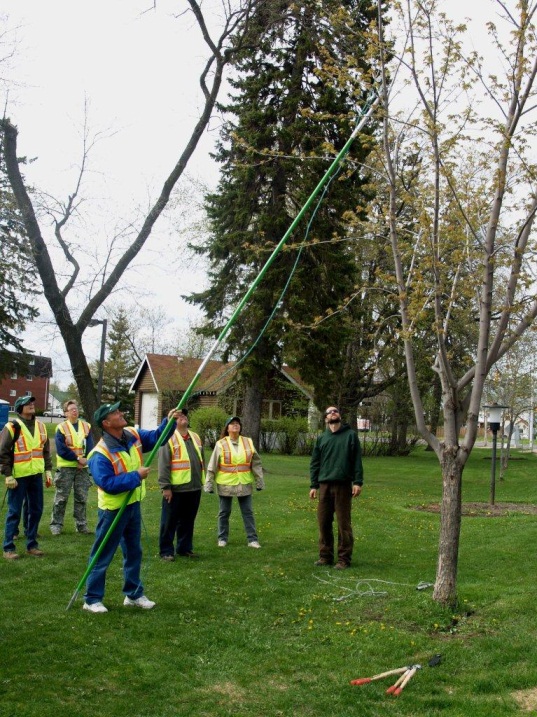
Using a TD Green Streets grant, Canada’s first Citizen Pruner Program was launched in 2010 by the City of Thunder Bay in conjunction with volunteer group Trees Thunder Bay. The program offered free tree pruning training to citizens, delivered by a local certified arborist. Citizen Pruners prune young trees to correct defects and direct strong growth, improinge tree quality and longevity, and addressing problems that could lead to costly future intervention, or premature failure and death. 75 volunteers have been trained since the program’s launch. This investment in the quality of Thunder Bay’s public trees will result in huge cost savings to the City – and, in turn, taxpayers.
(Photo: TD Friends of the Environment Foundation)
By including community involvement as a required component of funded projects, TD Green Streets rewards municipalities that empower local citizens to take an active role in the development, improvement, and maintenance of the urban forest. Programs selected to receive funding are also required to demonstrate relevance or applicability to other communities, such as the development of best practices manuals or translations of textual materials into other languages spoken in various communities. This model results in scalable methodologies; projects are considered successful if their approach and framework are transferable to another community. In addition to tree planting events with local citizens as participants, community engagement can take many forms such as town halls, volunteer training, or educational outreach, to name just a few.
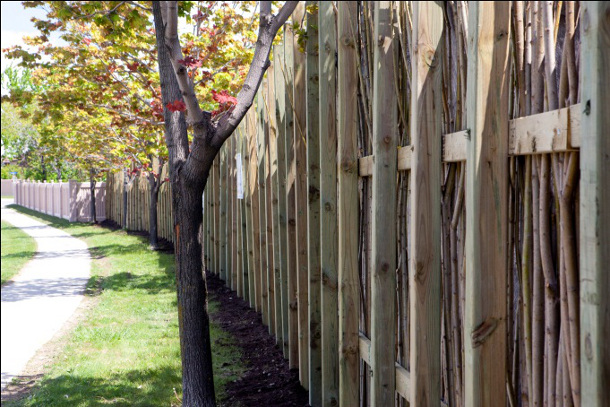
The City of Mississauga, ON wanted to combat both noise pollution and the City’s carbon foot print by planting more trees on selected sites.
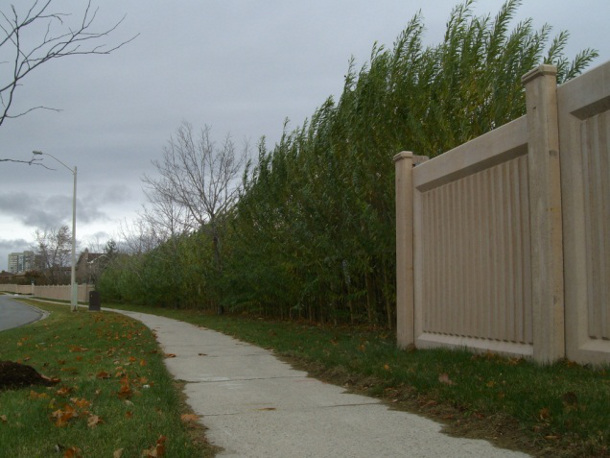
Using TD Green Streets funding, they created The Living Wall, an ecological sound barrier that offers an environmentally friendly alternative to standard sound barriers. Constructed of earth and trees (shrub willow), the barrier is enclosed in a biodegradable wooden structure. The willows were planted vertically into the ground, pressed up against a wall of soil, and restrained by geotextile. The trees will provide an almost instant landscape while also meeting sound absorption requirements. Over 100 residents, including students from a local school, were engaged in the project. (Photo: The City of Mississauga)
With its focus on community engagement, outreach, education, and sustainable innovation, TD Green Streets strikes me as an ideal place for artists to start becoming involved in order to further the impact of the projects being funded and as an opportunity to make tree care and tree planting into an art event relevant to the social ecosystem. Would this be a valuable approach to take? I certainly think so, even as a thought experiment to get readers’ gears turning regarding creative ways to engage their community and highlight the long term impact the urban forest has on our everyday lives (and those of future generations). Let’s see what Beuys has to say on the topic:
“I think the tree is an element of regeneration which in itself is a concept of time. The oak is especially so because it is a slowly growing tree with a kind of really solid heart wood. It has always been a form of sculpture, a symbol for this planet ever since the Druids, who are called after the oak. Druid means oak. They used their oaks to define their holy places. I can see such a use for the future…. The tree planting enterprise provides a very simple but radical possibility for this when we start with the seven thousand oaks.” (Joseph Beuys in conversation with Richard Demarco, 1982)
These words refer to Beuys’ monumental work of land art[2] 7000 Oaks – City Forestation Instead of City Administration, a project in which Beuys worked with volunteers to plant 7,000 oak trees throughout Kassel, Germany, each with an accompanying basalt stone.
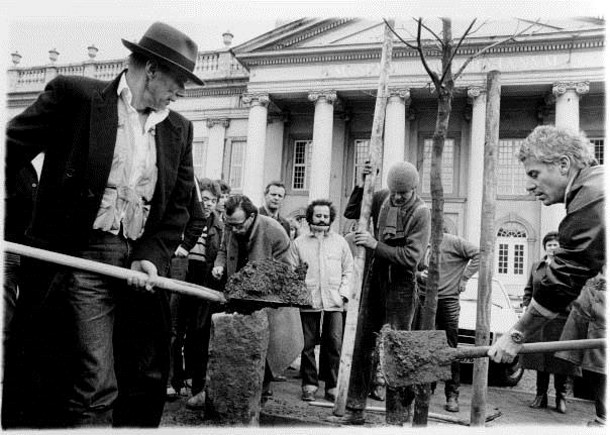
Beuys and volunteers planting one of the first Oak trees at documenta 7 in Kassel, Germany (1982).
Photo via Stephens College.
Begun in 1982 on the occasion of documenta 7[3], the implementation of this project spanned 5 years and outlived Beuys himself (the final tree was planted by his son Wenzel 1987). The trees were planted both as an affirmation of the existence of living objects that dwarf the human lifespan, as well as an enduring alteration of a public space through ecological intervention. Beuys worked with local community councils and citizen initiatives to determine where the trees would be planted, opening the doors for conversations among the participants regarding his philosophy and the effect of the project on city planning and future generations. Although the project was at first controversial among city officials, its transformative impact on the industrial landscape has made it not only an integral part of the cityscape, but a point of pride for the citizens. I see no reason why other large scale tree-planting or forest-sustaining projects should not become points of pride for their communities, becoming legacies for future generations to contemplate and enjoy, and be recorded in our shared cultural history as Beuys’ project was (and continues to be).
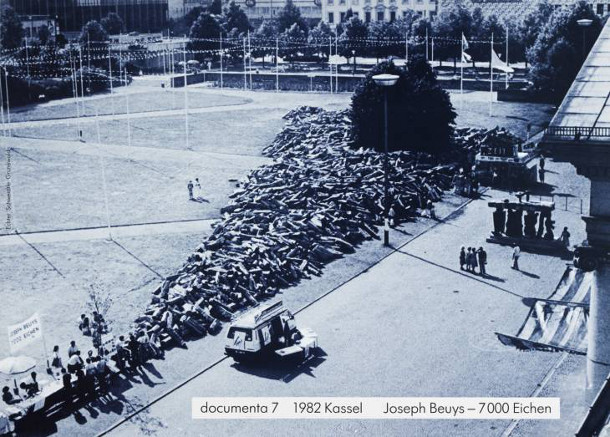
7,000 basalt stones were later paired with the newly planted oak trees. As seen here, the stones form an arrow that points to the site where the first tree was planted. Beuys explained the stone column this way: “The planting of seven thousand oak trees is thus only a symbolic beginning. And such a symbolic beginning requires a marker, in this instance a basalt column. The intention of such a tree-planting event is to point up the transformation of all of life, of society, and of the whole ecological system.”
Via Tate.org
In researching this article, I asked about the presence of art in past or ongoing TD Green Streets projects and I was pleased to hear that there were a few instances in which the creation of murals was proposed in order to celebrate or mark the tree plantings. Creative ways to engage the public are welcome and encouraged in applications. Remember, though, that creative methods for community engagement and enhancing awareness are complementary elements of a strong application and cannot form the core of a proposed project. That said, you might be surprised (in a good way!) at the innovative ideas your local artists have regarding ways to engage and educate your community about the urban forest. Brainstorming with them could help you to take your project to the next level. And may Beuys remind you that art is not limited to paintings, murals, sculptures, and objects. The trees you plant could be an art work, as can the act of planting and the conversation that surrounds it. With that said, I will close with a few tips of my own, from an artist who also works in green infrastructure:
Ideas for development of creative application
- Leverage digital technology in unique ways to engage and educate citizens as well as contribute to collaborative inventories (for example, incorporating opentreemap into a proposal).
- Reach out to your municipal arts commission/local arts institutions to connect with artists to develop ideas for engaging and educating the public (through events, murals, pamphlets, performances, exhibitions).
- Check out how other cities have worked with artists to draw public attention to green infrastructure projects, such as Philadelphia’s Soak it Up green infrastructure design competition and recent stormwater street art project; the interwoven relationship between art and stormwater management in Malmo, Sweden.
- Read about University of the Trees, a participatory, global, social sculpture for developing creative responses to the ecological crisis, through new ways of perceiving our relationship to the world and let your mind wonder.
- Connect with local museums, scientific as well as artistic, to explore opportunities to collaborate via workshops, events, exhibitions.
- Research Land Art for creative inspiration.
- Hug a tree, hug an artist, and hug a forester.
Good luck!
To learn more about TD Green Streets in Canada, visit tdgreenstreets.ca. The deadline to apply to the 2014 program is January 10, 2014.
For information about the program in the United States, visit tdgreenstreets.com. The deadline to apply for the 2014 program is December 20, 2013.
Special thanks to Natasha Alleyne-Martin of TD Friends of the Environment Foundation, Jim McCready of Tree Canada, and Jaci Klein of the Arbor Day Foundation for their formidable contributions to the research for this article
[1] by the Social Sculpture Research Unit at Oxford Brookes University : http://www.social-sculpture.org/category/territory/
[2] Land art (also referred to as Earthworks, or Earth art) is an art movement originating in the mid-twentieth century in which the work of art, or art object, are inextricably linked with the landscape. The works are often monumental in scope and involve the integration of “natural” materials that are a part of the landscape such as soil, bed rock, boulders, stones, logs, trees, and bodies of water with introduced, manmade materials such as concrete, metal, asphalt, or mineral pigments. Rather than simply being placed in the landscape, the resulting sculptures are a part of the landscape themselves.
[3] documenta is an exhibition of modern and contemporary art taking place every five years in Kassel, Germany. Founded by artist, teacher and curator Arnold Bode in 1955 as part of the Bundesgartenschau (Federal Horticultural Show), the exhibition began as an attempt to bring Germany up to speed with modern art, and since this time has become one of the most celebrated and influential regularly occurring exhibitions of modern and contemporary art in the world. http://www.documenta.de/






Leave Your Comment